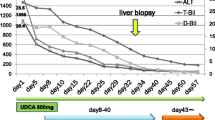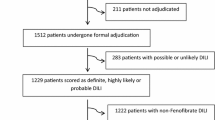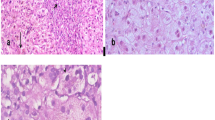Summary
A 68-year-old man developed hepatic injury with no hypersensitivity reaction after three years of hydralazine therapy. The liver injury histologically showed centrilobular zonal necrosis. Clinical, biochemical, and histological recovery followed discontinuation of the drug. Challenge tests and serial liver biopsies revealed that this liver injury was induced by hydralazine.
Similar content being viewed by others
Explore related subjects
Discover the latest articles and news from researchers in related subjects, suggested using machine learning.References
Jori GP, Peschle C: Hydralazine disease associated with transient granulomas of the liver. A case report. Gastroenterology 64:1163–1167, 1973
Knoblauch M, Cueni B, Spycher M, Schmid M: Dihydralazin-induzierte akute Hepatitis bei IgM-Mangel. Schweiz Med Wochenschr 107:651–656, 1977
Enat R, Rader G, Barzilai D: Leberschaden durch Adelphan. Schweiz Med Wochenschr 107:657–658, 1977
Zimmerman HJ: Hepatotoxicity. The Adverse Effects of Drugs and Other Chemicals on the Liver. New York: Appleton-Century-Crofts, 1978, pp 408–411
Zimmerman HJ: Hepatic injury caused by therapeutic agents.In The Liver, Part A, FF Becker (ed). New York, Marcel Dekker, 1974, pp 225–302
Koch-Weser J: Medical intelligence. Drug therapy. Hydralazine. N Engl J Med 295:320–323, 1976
Strandberg I, Boman G, Hassler L, Sjöqvist F: Acetylator phenotype in patients with hydralazine-induced lupoid syndrome. Acta Med Scand 200:367–371, 1976
Author information
Authors and Affiliations
Rights and permissions
About this article
Cite this article
Itoh, S., Yamaba, Y., Ichinoe, A. et al. Hydralazine-induced liver injury. Digest Dis Sci 25, 884–887 (1980). https://doi.org/10.1007/BF01338533
Received:
Revised:
Accepted:
Issue Date:
DOI: https://doi.org/10.1007/BF01338533




